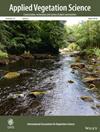Patch-Burn Grazing Increased Structural Heterogeneity in Southwestern North Dakota Rangelands
Abstract
Aims
Persistent land use change throughout the North American Great Plains increases the need to maintain and improve ecosystem service delivery from remaining rangelands to meet production and conservation goals. Vegetation structure is an ecosystem property influenced by management that has site selection and use implications for wildlife and livestock. In this study, we investigated the efficacy of patch-burn grazing to increase structural heterogeneity on semi-arid post-Conservation Reserve Program (CRP) grasslands in southwestern North Dakota.
Location
Hettinger Research Extension Center in Hettinger, North Dakota.
Methods
We surveyed plant community composition and structural characteristics in patch-burn grazing pastures during the 2017–2020 summer grazing seasons. Three pastures were stocked with cow-calf pairs and three were stocked with sheep. We also surveyed structural characteristics on units with conventional management (hay or idle) for active and post-CRP enrolled grasslands during the summers of 2018–2020. We tested for vegetative and structural differences between patches with varying time since fire and between grazer types on patch-burn pastures using mixed-effect models and ordination. We used variance partitioning to determine if structural contrast on patch-burn pastures increased over the study period and if structural contrast was higher on patch-burn grazing pastures relative to conventional management.
Results
Time since fire was significant for all structural characteristics, with recently burned patches being different from other patches. There were no structural differences between cattle and sheep pastures, but forb and legume cover were lower in sheep pastures. Structural contrast on patch-burn pastures increased over the study and was greater than conventional management.
Conclusions
Increased structural heterogeneity is important for supporting a broad suite of rangeland wildlife and can stabilize forage production. This study supports the expectation that patch-burn grazing with moderate stocking rates will increase structural contrast regardless of grazer type, but practitioners should consider which suites of species that management may benefit.

 求助内容:
求助内容: 应助结果提醒方式:
应助结果提醒方式:


